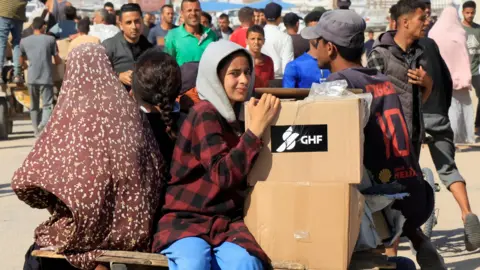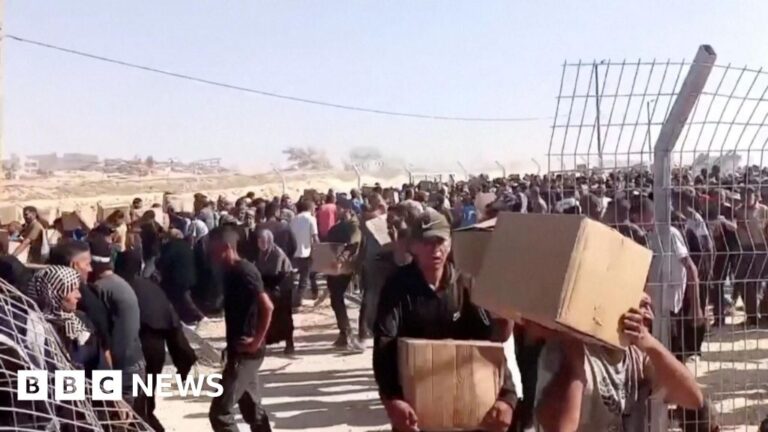The day after they began working there, the Palestinian crowd overrunned a distribution site in Gaza, founded by controversial US-Israel support groups.
The video shows people walking through torn fences and earth balms, a compound from the Gaza Humanitarian Foundation (GHF) in the southern city of Rafa.
The group said at one point the team had retreated because the numbers sought help were so high. Israeli forces said nearby troops fired warning shots.
Using armed American security contractors, GHF aims to bypass the United Nations as Gaza's leading aid supplier. There, experts are warning about looming hunger after the recently relaxed 11-week Israeli lockdown.
The UN said the video from Rafa was “heartbreaking” and there is a detailed plan that is ready to get enough assistance to a population of 2.1 million.
The UN and many aid groups have refused to cooperate with the GHF program. It states that this contradicts humanitarian principles and looks like “assistance.”
They warned that the system would actually eliminate people with mobility issues, force more exhaustion, harm thousands of people, condition aid on political and military purposes, and set unacceptable precedents for providing aid around the world.
Israel says that alternatives to the current aid system are needed to stop Hamas from stealing aid.
The GHF announced on Monday that it had “began operating in Gaza” and began providing supplies to Palestinians on its distribution site.
On Tuesday afternoon, Israeli forces confirmed that they began distributing food to their families, two sites located in Rafa's Tar al-Sultan area and two sites located in the Morag corridor, an East-West Army zone that separates the city from other parts of Gaza.
At about the same time, Israeli and Palestinian media shared photos showing long lines of Palestinians at the Tar al-Sultan site.
But just an hour later, they began posting videos showing thousands of men, women and children flowing into the compound. In one clip, some people run and ducking what appears to be a gunshot.
Witnesses described the scene of confusion as people seized food plots and other aid from the site. They also said that Israeli forces stationed nearby fired.
“The situation was very difficult. They allowed only 50 people to cross at a time,” one man told BBC Arabic's Middle East Daily Radio. “In the end, chaos broke out – people climbed up to the gates, attacked others, took everything (assistance).”
“It was a humiliating experience,” he added. “We are suffering greatly from hunger. We are just looking for a bit of sugar to drink tea, and we are looking for bread to eat.”
The woman said hunger and poverty “overwhelmed everyone.”
“People are exhausted – they are willing to do anything, and even risk their lives – just to find food and feed their children.”
A statement from GHF acknowledged that “ground needs are great” and said that through partnerships with local non-governmental organizations, they handed over about 8,000 food boxes aimed at feeding five and a half people in three and a half days each.
However, the Palestinians said they had experienced a few hours delay in accessing one site “due to the lockdown imposed by Hamas.”
“A moment in the late afternoon, the amount of people on SBS (Secure Distribution Site) has now retreated to allow a small number of Gazans to safely receive assistance and dissipate. This was done according to the GHF protocol to avoid casualties. Normal surgery has resumed,” he added.
The Israeli Defense Force (IDF) said the troops fired “warning shots in areas outside the compounds.”
“Control the situation has been established and food distribution operations are expected to continue as planned, and the safety of the IDF forces was not compromised,” he said.
Hamasran Government Media Office in Gaza said Israel's efforts to distribute aid “failed miserably.”
At a press conference in New York, United Nations spokesman Stéphane Dujarric said:
“We and our partners have detailed, principled, operational sound plans supported by Member States to obtain assistance to a desperate population. We continue to emphasize that meaningful scaling up of humanitarian operations is essential to stem hunger and meet the needs of all civilians wherever they are,” he added.
A US State Department spokesperson called the UN criticism “high hypocrisy.”
“The problem here is giving Gaza assistance, so that's a shame. And then suddenly we move on to complaints about style and who is doing it,” Tammy Bruce told reporters.
 Reuters
ReutersThe GHF will initially set up four distribution sites in Gaza, south and central, where Palestinians can gather food and other aid for their families. It says it aims to slightly reduce half its population by the end of this week.
The site is intended to be secured by American contractors, with Israeli forces patrolling the boundary line. To access them, it is expected that Palestinians will need to undergo identity verification and screening for their involvement with Hamas.
The United Nations and other aid agencies argue that they will not cooperate with schemes that do not respect the fundamental humanitarian principles of humanity, equity, independence and neutrality.
On Sunday night, Jake Wood resigned as GHF executive director, saying the group's system could not function to meet those principles.
The GHF board rejected criticism, accusing the focus of “tearing this more than getting help” of “benefiting from the status quo.”
The group also alleged on Monday that Hamas had made death threats against NGOs supporting distribution sites and attempted to prevent civilians from accessing aid.
Hamas has publicly warned Palestinians not to cooperate with the GHF system.
Israel was blocked into humanitarian aid and commercial goods in Gaza on March 2, and resumed military attacks two weeks later, ending a two-month ceasefire with Hamas. The measure said it was intended to put pressure on the armed groups and that up to 23 are believed to be alive to release the 58 hostages still held in Gaza.
On May 19, Israeli forces launched a broad attack that stated that Prime Minister Benjamin Netanyahu would see the troops that “control all regions” of Gaza. The plan reportedly includes a complete cleanup of civilians north and forcing them to move south.
Netanyahu also said Israel would temporarily ease the lockdown and allow “basic” amounts of food to be put into Gaza to prevent hunger under pressure from US allies.
Since then, Israeli authorities say they have granted Gaza humanitarian assistance to at least 665 trucks, including flour, baby food and medical supplies.
However, the head of the UN World Food Programme warned on Sunday that it was just a “bucket drop” of what the territory needs to reverse catastrophic levels of hunger amid a substantial shortage of basic food and surge prices.
According to the Unsupported Integrated Food Security Stage Classification (IPC) assessment, 500,000 people are facing hunger over the coming months.
Israel launched a military campaign in Gaza in response to an attack across Hamas border on October 7, 2023, killing around 1,200 people and taking 251 other people hostages.
At least 54,056 people have died in Gaza since, including 3,901 over the past 10 weeks, according to the Hamaslan Health Ministry of Territory.

